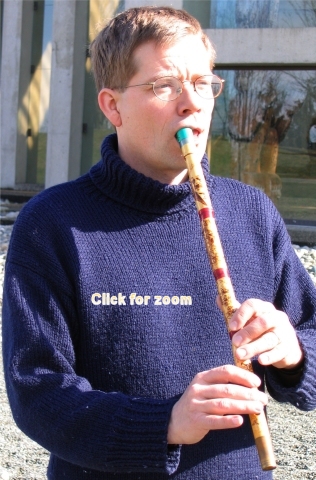
The ney is blown in a unique manner, which gives it its characteristic sound. The upper edge of the ney, which is just the top of a hollow cylinder, is placed between the two upper front teeth, inside the mouth. A small stream of air is directed with the tongue, and the upper lip surrounds the upper part of the ney. Moving the lip and tongue changes the pitch (up to a whole tone in both directions) and tone quality. Both timbre and loudness have infinite variety. This technique is very difficult to learn but once mastered gives great control over the sound, comparable only to the human voice. Advanced players control the amount of turbulence in the air stream allowing a large variety of sounds from pure tones to extremely breathy sounds.
Neys come in all sizes, in a range limited only by the reach of the fingers (for big neys) and the thickness of fingers (for small neys). Long neys are low pitched, and short neys are high pitched. I usually indicate the ney by the lowest note it produces, though the Iranian nomenclature identifies a ney by the lowest note in the third register, a fifth above the lowest note. So a ney with lowest note A (which I call an "A-ney") is officially called E-kuk, or Mi-kuk. To add to the confusion, the Arabic and Turkish neys are named after the pitch produced when you play the note just above its lowest note.
The shortest ney I have is F#, or C#-kuk. It is so small I can hardly fit my fingers on the hole as they are crowded so closely together. The longest ney I have is F (C-kuk), an octave lower, and morethan twice as long as the longest I have. It is so long that my right hand can just barely reach the holes. People who are shorter than me (I am 1.80m tall) can't reach the holes at all. A picture of some of these neys is on my purchase page.
A similar instrument also called ney is used throughout the middle east, but is blown with the lips and has a much more limited sound. A Persian ney can also be blown with the lips, but this style can not be mixed with the interdental technique as the ney sounds a semitone higher when blown with the lips. Neys have been found in Egyptian tombs dated 5000 years ago. I have been playing the Persian ney since 1994, learning mainly from listening to tapes and an occasional lesson from visiting musicians from Iran. After practicing for thousands of hours I can now play somewhat decently. I live in Vancouver, Canada, and I perform regularly with players from the local Persian community. Here is a of myself at seom concert.
I have a large collection of high quality neys for sale and for my students. Send me an email (see purchase page) if you are interested in buying one from me. I also teach ney long distance through telephone and if necessary internet video. I can also help through email with questions you have, but don't ask me questions before reading my webpage as I think I put everything you need to know there. This is not a business for me, rather an opportunity for me to share this wonderful instrument with others.
I have produced a CD with Sara Goudarzi; poetry reading and ney, see here and another with the Keemia ensemble, see here